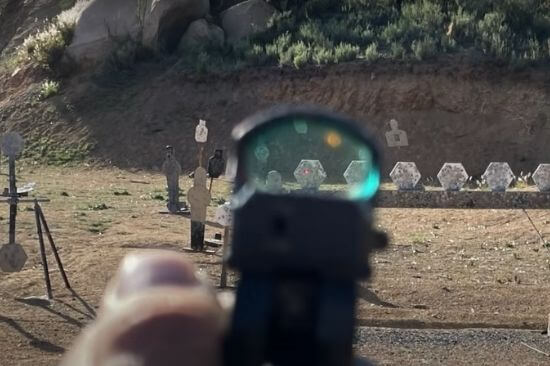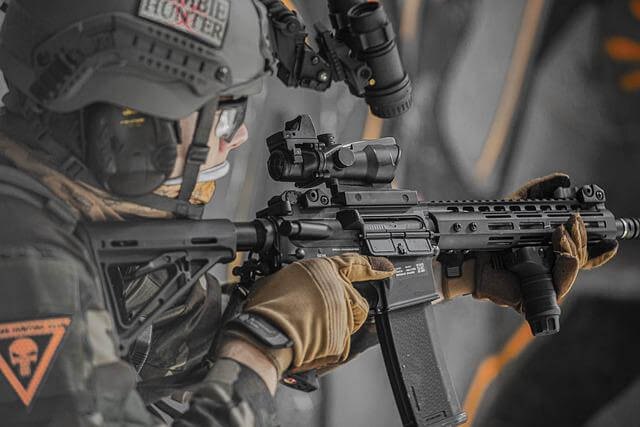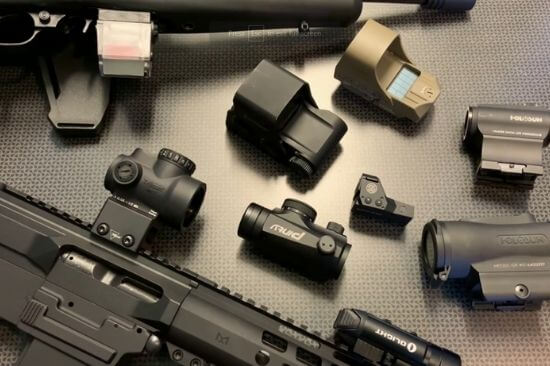This site contains affiliate links. As an Amazon Associate, I earn a commission from qualifying purchases at no extra cost to you. Full Disclosure Here.
Are you the proud owner of a brand new red dot sight? Or maybe you’ve read our list of the best red dot sights and are doing some research while you wait for your red dot sight of choice to arrive.
Whatever the case may be, if you’re looking to learn how to sight in a red dot quickly, you’ve come to the right place.
In this guide, we’ll go over everything you need to know in order to rapidly sight in your red dot so you can take it out to the range to play right away. We’ll also go over a few other odds and ends you should know about sighting red dots and red dots in general, so you’re as informed as possible.
Also Read: Vortex Viper vs. Venom Red Dot Sights: Which Is Better?
Now, without any further delay, let’s hop right in with some basics:
Red Dot Scope vs. Red Dot Sight

First things first, let’s clarify a common misunderstanding.
You’ll sometimes hear the phrase “red dot scope” tossed around by people who don’t really know what they’re talking about.
The thing is, there’s actually no such thing as a red dot scope. It’s a misnomer sometimes applied to red dot sights, but red dot sights aren’t scopes.
By definition, a scope is a magnifying optic. It uses lenses to make objects viewed through the scope appear larger, making it easy to line up shots over distances.
Sights, including red dot sights, are not magnifying. They just help you predict the flight pattern of the bullet you’re about to shoot. Red dot sights can be paired with separate magnifiers to make your target appear larger, but they’re still not scopes.
How to Sight in a Red Dot Scope Without Shooting?
Okay, so if we’re being completely honest, you do need to do at least a few shots to accurately sight in your red dot sight, just like any other sight.
Fortunately, you can get pretty darn close by a process referred to as “bore sighting,” just don’t expect sub-MOA groupings from bore sighting alone.
On the other hand, bore sighting is a common first step used by all kinds of shooters looking to sight in their sights and optics. This is because it allows you to get the optic pretty darn close to accurate without wasting time and ammo.
For a truly accurate sight, you’ll still want to follow up with some shots to really finesse that final sighting. For a quick and dirty setup, though, bore sighting alone will do the job. It’s also worth noting that bore sighting is more effective the closer you are to your target. Once you get beyond about 50 yards, the compounding effect of all the little imperfections of the setup will mean your accuracy is more or less in the toilet.
But now that you have a reasonable expectation for what’s possible with bore sighting, what is bore sighting anyway, and how do you do it in the first place?
Getting Ready
Well, to start, you’ll need, unsurprisingly, a bore sight. Basically, a bore sight is a laser pointer that goes into the bore (either the barrel or chamber) of your firearm (since they go into the bore, you’ll need to make sure your bore sight is compatible with the caliber of your firearm).
You can then use the laser to roughly estimate the path of your rounds. Obviously, the laser doesn’t take into account bullet drop or environmental conditions.
There are a bunch on the market at a wide range of price points. Generally, the more expensive the bore sight, the more accurate it will be, though there are of course exceptions. Still, it’s worth shelling out for one that’s at least mid-range.

I’m personally quite partial to the LaserLyte Universal Laser Bore Sight, but if you want something more high-end, I also like the Wheeler Professional Laser Bore Sighter.
Once you’ve got your bore sight, you’ll want to go ahead and mount your red dot to your gun, then place your bore sight in your gun’s chamber or barrel according to the manufacturer’s instructions.
Lastly, you’ll need a target that’s about 25 to 50 yards away. That’s about where the range of a bore sight’s laser tops out, so you really can’t use a target any farther out than that. On the other hand, the farther out you sight the red dot, the more accurate it will be, so try to go as close to the laser’s max range as you can.
Sighting Your Red Dot

Once all that’s set up, you can actually get started with sighting.
Start by getting the bore sight’s laser lined up with the center of the target, ignoring the red dot itself. You’ll want to keep the gun in this alignment using something that’s preferably not your own hands. A gun rest is one of the easiest ways to do this, but clamps or heavy objects like stand bags, weights, or books can also be used.
Now you can turn your attention to the red dot. Use the windage and elevation controls to align the sight’s reticle with where the laser hits the target. You may need a special tool that comes with your sight to do this, or you might just need a flathead screwdriver, coin, or other flat, hard object.
If you’re having a hard time sighting the dot, you can try at a closer range, then move your target farther out and make smaller adjustments.
How Hard Is It to Sight in a Red Dot?
Sighting in a red dot is actually quite easy, as long as you know what to do. The process is basically the same whether your red dot is mounted on a pistol, rifle, or shotgun. Only the range differs.
I generally recommend 100 yards, but you could go closer or farther depending on your needs. Handguns, for example, will generally be sighted in at a much closer range. If you enjoy precision rifle shooting, you may want to sight in your red dot sight at a farther distance, if that’s where you prefer to shoot.
To make it as easy as possible, start with the bore sighting method described above to get it roughly sighted.
Then move the target out to the distance you actually want the red dot sighted for, if necessary. If your red dot is mounted to a pistol, you may not need to move your target at all.
Now, simply fire off a single round. Check how close it is to where your dot said and adjust accordingly. Repeat until your hits consistently match up with the red dot’s reticle.
Shotguns obviously won’t have a single hole, so you’ll want to line up the reticle with the center of the spread. Fortunately, you don’t have to be super accurate with shotguns.
That’s all there is to it!
Do Red Dot Sights Need to Be Sighted in?

To get the most accurate performance from your red dot, you need to take the time to sight it properly. Fortunately, the sighting process is quick and easy.
Bore sights are great for a quick and dirty sighting in. Then you should only need to fire off a few shots to get your red dot sight nice and accurate.
What Distance Is a Red Dot Sight Good for?

In short: the optimal range of a red dot sight is right around 100 yards, but they can be effectively used even further.
Got it? Great! Then let’s go into a bit more detail:
Because red dot sights aren’t magnified, they’re really best for close-range to mid-range shooting.
With that said, there are a lot of different factors that affect a red dot sight’s range. For example, the amount of light, the size of the dot, the size of the target, and a variety of environmental factors can all make a big difference.
In general, though, you’ll want to sight your red dot in at 100 yards. You can certainly shoot accurately farther than that using a red dot, but within 100 yards is really the most effective range.
With a magnifier, you can stretch the range even more, but magnifiers are the exception, not the rule, and how much you can extend the range depends on the strength of the magnifier anyway.
Can I Zero a Red Dot Without Shooting?
As discussed above, to properly zero your red dot, you need to shoot at least a few rounds, but you can get pretty close without shooting.
Also Read: 7 Best M&P Shield Night Sights in 2022
Wrapping Up
And there you have it on sighting in red dot sights quickly.
By now, you should know everything that you need to in order to get your red dot sighted right away.
You do need to spend a bit of time bore sighting any new sight or optic, but hopefully with the information you’ve been given here, that process is as quick and easy as possible with your red dot. That way, you can spend less time sighting and more time shooting.
Fortunately, red dots are much faster and easier to sight than magnified optics, since you don’t have to sight them for longer distances.
Now get your red dot sighted and get to shooting!

